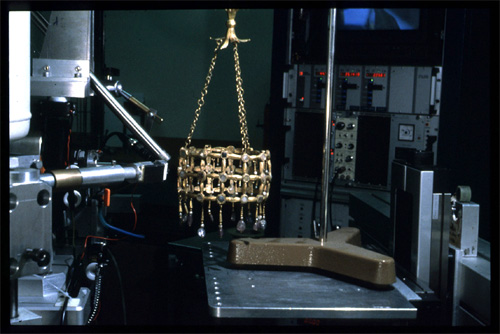The impurities witness the origin of precious stones
Knowing the background of the material gives a base to know the trade routes and relations between ancient people. A common example of this is through the assessment of the origins of the rubies of a Parthean statue, discovered in Mesopotamia, whose previous analysis that took place at the Louvre had already proved the authenticity.

Visigoth Tiara of Guararazar
This crown of the treasure of Guarrazar (Spain) is shown in position ready to be analyzed by the beam of particles extracted from AGLAE. This treasure was buried in haste at the time of the Arab invasion by the last Visigoth king. The aim of this analysis is to determine the source of the emeralds of the tiara.
© LRMF
The Parthean Empire lasted around five centuries from 250 before JC to 250 after JC. It was situated within the boundaries of the Roman Empire, where Iran is now located. To determine the history of these rubies of the Goddess Ishtar, the Louvre laboratory has measured using the PIXE method the composition of around 500 rubies from different mines. Every ruby was characterised by different traces of natural elements.
The composition of rubies of the statue has been compared to the rubies of all the mines from where the precious stone may have been extracted. Traces of natural elements of the rubies on the statue indicated that they came from Burma, which was an important testimony to a trade route of precious gems between Mesopotamia and the Far East
More recently, this method has been applied to the study of the origin of emeralds belonging to Visigoth votive crowns. The Visigoths dominated Spain, from the fall of the Roman Empire to the Arab conquest. The crowns belong to the royal treasure of Gurrazar (VIII century) near Toledo, part of which is conserved in the National Museum of the middle ages in Paris.

PIXE analysis of a tiara emeralds
This energy spectrum shows the energy distribution of X-rays detected during the irradiation of an emerald by the particle beam of the accelerator AGLAE. One observes the presence of characteristic lines signatures of zinc, rubidium and caesium impurities. Like “DNA” identification, these impurities establish that these emeralds belonging to a crown of Visigoth treasure of Guarrazar (Spain) came from a mine in Tyrol.
© LRMF
The impurities detected at the level of traces by the PIXE and PIGE methods could be compared, using a police image, to genetic fingerprints. They have led to the conclusion that these emeralds had most probably been extracted from the Habachtal mines, in Tyrol. It is an interesting result because, the exploitation of these mines was only attested much later on, towards the XV century.